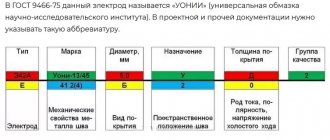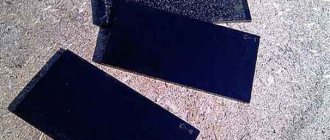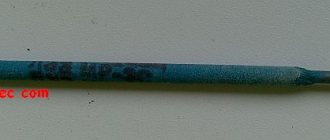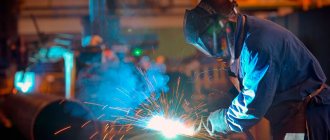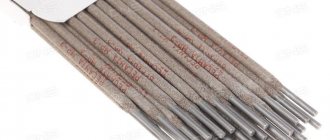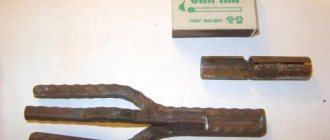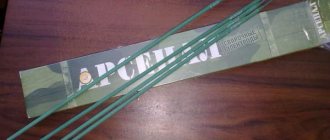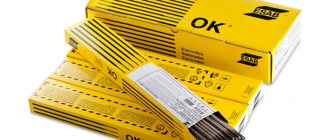Planning plays a major role in production and construction processes. This concerns not only the financial aspect, but also the stocks of materials and consumables necessary for the assembly or construction of the structure. These parameters need to be calculated before work, so that in the future there will be no difficulties with production and lack of resources.
Speaking about welding, it is necessary to clarify that the consumption of electrodes is of great importance, for the most part, only for large industries where a huge number of consumables are involved. For a household, parameters such as consumption per meter of weld and 1 kg of deposited metal do not matter.
What affects the consumption of electrodes?
Before you start calculating consumption, you need to find out what exactly affects it. There are several main parameters on which consumption depends:
- seam length and depth;
- the weight of the deposited metal, determined relative to the entire structure;
- weight of deposited metal per meter of weld;
- type of welding work.
Consumption depends on several factors, which together can give quite large numbers. That is why it is very important to carry out preliminary calculations and only after that order electrodes and begin work.
How to count by piece
To calculate the number of electrodes, you can use the basic formula N=Vnm*K and a table of correction factors.
The weight of the deposited metal is taken from the table:
| Compound | Parts Thickness/Gap (mm) | Vnm, g/m |
| Ceiling | 4/2 | 70 |
| 7/3 | 130 | |
| 6/2,5 | 140 |
Apply a coefficient that corresponds to the selected type of electrode. The calculation result is multiplied by the length of the seam and divided by the weight of 1 product.
In the following example, for 1-pass welding of workpieces 1.5 mm thick, OZL 6 electrodes with a diameter of 4 mm and a length of 450 mm are used. The length of the seam is 8 m. A vertical joint is created with smooth edges with an initial gap of 0.5 mm.
An algorithm is used to calculate the number of electrodes.
Calculation algorithm:
- subject to standard technology, take 0.02 kg per meter of connection, which in total for the specified length is 0.16 kg = 0.02 * 8;
- when working with OZL-6 electrodes, a correction factor of 1.6 is used;
- get the total weight of consumables (0.16-1.6=0.256 kg);
- taking into account the typical weight of 1 product (58 g), calculate the consumption in pieces (256/58 = 4.4);
- make a reserve to take into account possible errors 4.4*1.08=4.45;
The resulting value is rounded up, which allows you to find out the number of electrodes to create the corresponding welded structure. It is equal to 5 pcs.
Calculations in theory and practice
The consumption of certain electrodes is a tabular value, but they can be calculated independently. There are 2 methods for this, universal for various types of materials. The first uses the following formula:
H = M*K
- M is the weight of the structure;
- K - coefficient consumption taken from reference literature (1.5 - 1.9).
The second method is calculated using the formula:
G = F*L*M
- F is the cross-sectional area;
- L—seam length;
- M - weight 1 cu. see consumables.
These are all theoretical calculations, but in practice the cinders, current and voltage, as well as the length of the connection are also of great importance.
Counting Features
The information presented is used to calculate costs for welding work.
The final result is influenced by the following factors:
- connection type;
- thickness, clearance, relative position of parts;
- ease of access;
- brand of electrodes;
- current values.
The final result is influenced by the type of connection.
The calculation method is chosen taking into account the characteristics of technological operations.
Per ton of metal structures/reinforcement
When performing large-scale work, tabular data on consumption per ton of metal (Kr) is used. This standard indicator is established taking into account the parameters noted above. Select the position corresponding to the type of electrode. By multiplying by the mass of the structures, the amount of consumables is obtained. They add a margin for errors and other associated losses. Converting to pieces for such volumes does not make practical sense.
For 1 m seam
For calculations, you can apply the considered formulas and test results. To simplify calculations, use tabular data. Below is information on the standard consumption in kilograms per 1 m of welded joint.
This example uses a backing with 1 beveled edge.
| Thickness of parts, mm | Vnm, kg | Electrode group | ||||
| II | III | IV | V | VI | ||
| 3 | 0,232 | 0,411 | 0,438 | 0,466 | 0,493 | 0,521 |
| 5 | 0,384 | 0,680 | 0,724 | 0,77 | 0,816 | 0,861 |
| 8 | 0,832 | 1,474 | 1,573 | 1,671 | 1,769 | 1,868 |
| 12 | 1,562 | 2,765 | 2,949 | 3,133 | 3,318 | 3,502 |
If pipes are welded
As in the previous example, instead of calculations using formulas, it is more convenient to use prepared standards. The information in the table is presented for similar initial conditions: only 1 edge of the joint is beveled, a lining is left that prevents the penetration of molten metal into the structure. Consumption is given in kg.
| Pipe dimensions (diameter x wall thickness), mm | Vnm | Electrode group | ||||
| II | III | IV | V | VI | ||
| 57x3 | 0,041 | 0,072 | 0,077 | 0,082 | 0,087 | 0,091 |
| 89x6 | 0,128 | 0,227 | 0,242 | 0,27 | 0,272 | 0,288 |
| 133x6 | 0,193 | 0,342 | 0,365 | 0,388 | 0,410 | 0,433 |
| 159x8 | 0,482 | 0,724 | 0,772 | 0,820 | 0,869 | 0,917 |
For 1 kg of surfacing
Some manufacturers indicate in the accompanying documentation the value of the deposition coefficient (KN) for the selected type of consumables when working with the recommended current range.
| Electrode brand | Kn, g/A*h | Consumption of electrodes per kilogram of deposited metal, kg |
| OZS-6 | 8,5-10,5 | 1,5 |
| EA-395/9 | 10-11,5 | 1,6 |
| UONI-13/55 | 9-10 | 1,6 |
Errors arising during calculations
It is almost impossible to calculate everything exactly. In any situation there will be small “disagreements” with what was originally planned. Practical methods for calculating electrode consumption are much more accurate than theoretical ones, but even with them it can be difficult to predict how the joint will turn out and how the material will behave. Errors can occur for various reasons:
- welding mode and currents;
- features of the electrodes used for work;
- welder skill, etc.
Every time you calculate the consumption of materials, you need to include an error in the final figure. The standard error value is approximately 5 - 7%. If after the work it turns out that the consumption significantly exceeded the permissible error, it means that some process violations occurred during welding.
Even if the number of consumables is calculated as accurately as possible, you need to have a small reserve to insure against defective rods.
Way to reduce costs
To improve economic performance, it is necessary to strictly implement technological rules. The qualifications of the welder are essential. To eliminate errors and inaccuracies caused by human factors, specialized automatic machines are used. Investments in the purchase of more complex equipment pay off during operation by reducing consumables consumed by 10-15%.
To reduce costs, you need to strictly follow technological rules.
Electrodes should be used only in the modes recommended by the manufacturer.
Deviations from the design current increase the consumption of materials or deteriorate the quality of the weld.
If manual technology is used, the final result largely depends on the skills of the welder. For this reason, some experts prefer a practical calculation method. By creating several control seams, you can accurately determine the material consumption under working conditions.
We recommend reading Which aluminum electrodes to choose
How many electrodes are contained in 1 kg?
Once all the data on the required volume of materials has been received, you can begin purchasing consumables. This brings up another question: how many packs of rods should I buy? To determine this, you need to count how many rods are contained in 1 kg. A kilogram is the standard packaging of electrodes. It is important to consider all the parameters here:
- diameter;
- length;
- weight;
- packaging thickness;
The larger these parameters, the fewer electrodes in the pack. Despite all these parameters, the average weight of the electrode can be determined by its diameter. This table shows the average weight of electrodes with different, most commonly used diameters:
| Diameter, mm | Average weight, g |
| 2,5 | 17 |
| 3 | 26 |
| 4 | 57 |
| 5 | 82 |
Why is it necessary to know the exact number of electrodes?
The productivity and duration of welding directly depends on the presence/absence of a sufficient amount of consumables. The used filler product must be promptly replaced with a new one. When the electrode is not at hand, this directly affects the pace of work. Purchasing filler material takes time, which leads to welding stops. A situation where a few kilograms are missing is considered uncritical. Welding large metal structures, on the contrary, requires a huge number of electrodes. Errors here are calculated by the lack of a huge number of consumables. The need for preliminary preparation of a large number of filler products significantly slows down the work process, which can disrupt all deadlines for the delivery of the object.
How is the consumption per meter of seam calculated?
Many sites offer the ability to calculate electrode consumption online. This is done very simply - you need to enter a few numbers and the calculator will give you the required value.
Experienced welders prefer to calculate everything themselves. They use the following formula for this:
N = Nsv + Npr + Nright
- Nsv - welding consumption;
- Npr - expense for affixing tacks;
- Nprav - consumption for corrections carried out with idle rollers.
The rate of consumption for tack work is determined relative to the consumption for other work. With a structure thickness of up to 1.2 cm, it is 15% of the main consumption. With a thickness of more than 1.2 cm - 12%.
Practical flow calculation
It is carried out experimentally. The mass of the metal is determined and test welding is performed. When they are finished, the cinder is measured taking into account the voltage and current, as well as the length of the seam made. These parameters allow you to calculate how many electrodes were required for this particular area. Knowing the length, it will not be difficult to calculate how much filler material will be required to complete the weld in a particular section. The accuracy of the calculation varies. The error is minimal only in cases where the position angle and external data remain unchanged during further welding. In other words, the conditions will remain similar to the test ones. If they do not use formulas, they carry out practical tests and do from two to four tests. This allows you to reduce the likelihood of error and obtain data that will be more accurate than using mathematical calculations.
How is consumption calculated when welding pipes?
In theory, the calculation of this parameter is very simple. It is necessary to divide the consumption per meter of seam by the weight of one electrode. The results will show the number of rods required for the job. The number of rods must be multiplied by the footage. The resulting figure is rounded up.
To get the value in kilograms, you need to carry out the following calculations: divide the volume of the section by the density of the metal. The first parameter is the volume of the cylinder (the diameter is taken along the larger side of the joint). The resulting value must be multiplied by 1.4 - 1.8. This is a correction for cinders.
The consumption when welding pipes may differ depending on the joints being connected - the presence/absence of bevels, etc.
Correction factors
For more accurate calculations, correction factors are used. Their complete list can be found in VSN 452-84. Here are examples of amendments depending on work tasks:
• When welding rotary joints
| Welding type | Electrode type | Coefficient |
| MMA welding | for coated electrodes | 0,826 |
| TIG welding | for consumable electrode | 0,930 |
| for tungsten electrode non-consumable | 1 |
• When welding pipes located at an angle to the main axis of the pipe (by default, the angle is taken to be 90°)
| Connection angle | Coefficient |
| 60° | 1,1 |
| 45° | 1,23 |
• When the pipes are positioned on the side or below in relation to the main pipe
Ways to save materials
There are several ways to save on consumables. This will reduce the cost of purchasing rods:
- Use automatic and semi-automatic machines. When manual welding, losses of more than 5% may occur. Remember that the higher the quality of consumables and equipment, the more efficient the welding is, which means fewer losses occur.
- Different brands and models of electrodes work with different currents. When setting up the device, pay attention to this. If you select the wrong welding modes, you can suffer large losses.
- Welding technology affects consumption. So, if the rod angle is incorrect, the flow rate may increase.
Experienced welders find out in practice which welding angle is optimal. This enables them to work quickly and economically.
By adhering to such recommendations, choosing the right electrodes and carefully adjusting the equipment, you can significantly save material consumption.
How to reduce costs?
There are several conditions that allow you to save on consumables for welding work, but do not in any way affect the quality:
- The greatest savings in additives can be achieved by using a semi-automatic or automatic welding machine. When work is carried out manually, the losses range from five percent or more. With an automatic and semi-automatic process, this figure is half as much. If both the additives and the apparatus are of high quality, the reduction in consumables will be maximum.
- The current and voltage indicators must fully correspond to the selected filler material. Therefore, when setting up a welding machine, you need to pay special attention to these parameters.
- The number of spent electrodes under equal conditions may differ. This is due to the position of the consumable item during welding. Therefore, many welders prefer to go beyond formulas and resort to practical calculations, conducting several tests to find the “ideal” position.
Compliance with these three important conditions and a competent choice of ways to save money allows you to reduce the amount of required filler material by almost thirty percent. This is quite an impressive amount in monetary terms.
Read also: Restoring the capacity of a li ion battery
Home page » About welding » Electrode consumption, standards, tables, how to calculate
An important part of any production or construction process is accurate and competent planning of material consumption, which is carried out to draw up estimates and calculate financial costs. When erecting metal structures by welding, it is important to know not only the metal consumption, but also the required number of electrodes. A correctly performed calculation will allow you to find out the exact cost of the work, and the welding process will be carried out according to plan.
It should be noted that calculating the consumption of welding electrodes is relevant and in demand only during the construction of large facilities . The large scale of work requires an accurate determination of the volume of materials, which will be included in the construction estimate. For this purpose, the concept of “electrode consumption per 1 ton of metal structures” was introduced.
Expense tables
Now let's take a closer look at the tables of standard consumption values for various electrodes and types of welding.
Consumption per kilogram of deposited metal
Welding carbon and low alloy steels
Type E42
| Brand | WCC-4 | OES-23 | ANO-6 | ANO-17 | OMA-2 | VSC-4M |
| Consumption, kg | 1,6 | 1,65 | 1,7 | 1,8 | ||
Type E42A
| Brand | SSSI 13-45 | USENI 13-45A |
| Consumption, kg | 1,6 | 1,7 |
Type E46
| Brand | Consumption, kg |
| OZS-6 | 1,5 |
| ANO-13 | 1,6 |
| VRM-26 | |
| ANO-21 | 1,65 |
| ANO-4 | 1,7 |
| ANO-24 | |
| ANO-34 | |
| VRM-20 | |
| MR-3 | |
| OZS-12 |
Type E46A
| Brand | USENI 13-55K | TMU-46 |
| Consumption, kg | 1,6 | 1,65 |
Type E50
| Brand | WCC-3 | 55-U |
| Consumption, kg | 1,7 | 1,8 |
Type E50A
| Brand | Consumption, kg |
| OZS-18 | 1,5 |
| TMU-21U | |
| OZS-25 | 1,6 |
| OZS-28 | |
| OZS-33 | |
| ANO-27 | 1,65 |
| ITS-4 | 1,7 |
| SSSI 13-55 | |
| TsU-5 | |
| TsU-7 |
Type E55
| Brand | MTG-02 |
| Consumption, kg | 1,55 |
Type E60
| Brand | MTG-01K | VSF-65 | OZS-24M | SSSI 13-65 |
| Consumption, kg | 1,55 | 1,6 | ||
Welding steels with a high content of alloying components
| Brand | Consumption, kg |
| OZL-36 | 1,5 |
| ZIO-3 | 1,55 |
| EA-898/19 | 1,6 |
| OZL-14A | |
| ANV-32 | |
| EA-606/10 | 1,7 |
| TsT-15 | |
| TsT-15K | |
| TsL-11 |
Welding of corrosion-resistant steels
| Brand | OZL-8 | OZL-14 | OZL-12 | EA-400/10U | EA-400/10G |
| Consumption, kg | 1,7 | 1,75 | 1,8 | ||
Welding steels resistant to high temperatures
| Brand | Consumption, kg |
| TML-1, TML-1U, TML-3U | 1,5 |
| TsU-2M, TML-3, TsL-27A | 1,55 |
| UONI 13-15M, UONI 13-ХМ, TsL-39, TsL-36, TsL-40, TsL-17 | 1,6 |
| TsL-26M, TsL-41 | 1,65 |
| TsL-6, TsL-55, ANV-1 | 1,7 |
| TsL-10 | 1,75 |
| OZS-11 | 1,8 |
Welding of dissimilar steels
| Brand | IMET-10 | ANZHR-2 | ANZHR-1, NII-48G |
| Consumption, kg | 1,3 | 1,6 | 1,7 |
Welding of heat-resistant steels
| Brand | NIAT-5, EA-395/9 | TsT-10 |
| Consumption, kg | 1,6 | 1,7 |
Connections without beveled edges
| Seam position | Metal thickness, mm | Gap, mm | Weight of deposited metal, kg/1 m of weld |
| Lower | 1 | 0 | 0,02 |
| 1,5 | 0,5 | 0,02 | |
| 2 | 1 | 0,03 | |
| 3 | 1,5 | 0,05 | |
| 4 | 2 | 0,13 | |
| 5 | 2 | 0,16 | |
| 6 | 2,5 | 0,21 | |
| 7 | 3 | 0,28 | |
| Horizontal | 1 | 0 | 0,02 |
| 1,5 | 0,5 | 0,03 | |
| 2 | 1 | 0,04 | |
| 3 | 1,5 | 0,07 | |
| 4 | 2 | 0,17 | |
| 5 | 2,5 | 0,2 | |
| 6 | 3 | 0,25 | |
| 7 | 3 | 0,33 | |
| Ceiling | 4 | 2 | 0,08 |
| 5 | 2 | 0,13 | |
| 6 | 2,5 | 0,14 | |
| 7 | 3 | 0,16 |
Corner connections
| Options | Weight of deposited metal, kg/1 m of weld | ||||
| Metal thickness, mm | Weld section, sq. mm | ||||
| 2 | 2 | 0,03 | 0,02 | 0,03 | 0,03 |
| 3 | 4,5 | 0,05 | 0,05 | 0,05 | 0,06 |
| 4 | 8 | 0,07 | 0,07 | 0,07 | 0,08 |
| 5 | 12,5 | 0,1 | 0,11 | 0,11 | 0,13 |
| 6 | 18 | 0,15 | 0,15 | 0,16 | 0,17 |
| 7 | 24,5 | 0,2 | 0,21 | 0,22 | 0,25 |
| 8 | 32 | 0,26 | 0,27 | 0,28 | 0,32 |
| 9 | 40,5 | 0,33 | 0,34 | 0,36 | 0,4 |
| 10 | 50 | 0,4 | 0,42 | 0,44 | 0,5 |
| 11 | 60,5 | 0,49 | 0,53 | 0,57 | 0,62 |
| 12 | 72 | 0,58 | 0,62 | 0,66 | 0,73 |
| 15 | 113 | 0,91 | 0,97 | 1,04 | 1,11 |
| 18 | 162 | 1,31 | 1,37 | 1,49 | 1,6 |
| 20 | 200 | 1,62 | 1,62 | 1,78 | 1,98 |
| 22 | 242 | 1,95 | 2 | 2,16 | 2,39 |
| 25 | 323 | 2,58 | 2,6 | 2,9 | 3,18 |
T-joints
| Options | Weight of deposited metal, kg/1 m of weld | ||||
| Metal thickness, mm | Weld section, sq. mm | ||||
| 2 | 4 | 0,04 | 0,05 | 0,04 | 0,04 |
| 2,5 | 6,5 | 0,06 | 0,07 | 0,06 | 0,07 |
| 3 | 9 | 0,08 | 0,1 | 0,09 | 0,09 |
| 3,5 | 12,5 | 0,11 | 0,13 | 0,12 | 0,13 |
| 4 | 16 | 0,14 | 0,16 | 0,15 | 0,17 |
| 4,5 | 20,5 | 0,18 | 0,2 | 0,19 | 0,21 |
| 5 | 25 | 0,22 | 0,25 | 0,24 | 0,26 |
| 5,5 | 30,5 | 0,26 | 0,29 | 0,28 | 0,32 |
| 6 | 36 | 0,31 | 0,33 | 0,34 | 0,37 |
| 6,5 | 42,5 | 0,37 | 0,39 | 0,4 | 0,44 |
| 7 | 49 | 0,43 | 0,45 | 0,44 | 0,51 |
| 7,5 | 56,5 | 0,47 | 0,51 | 0,5 | 0,58 |
| 8 | 64 | 0,55 | 0,58 | 0,6 | 0,65 |
| 9 | 81 | 0,69 | 0,74 | 0,75 | 0,86 |
| 10 | 100 | 0,85 | 0,89 | 0,91 | 1,02 |
| 11 | 121 | 1,03 | 1,08 | 1,12 | 1,23 |
| 12 | 144 | 1,22 | 1,27 | 1,33 | 1,48 |
| 13 | 169 | 1,41 | 1,49 | 1,53 | 1,73 |
| 14 | 196 | 1,62 | 1,76 | 1,78 | 2,02 |
| 15 | 225 | 1,86 | 1,95 | 2,07 | 2,31 |
V-connections (one way)
| Metal thickness, mm | Gap, mm | Weight of deposited metal, kg/1 m of weld | ||||
| Seam position | ||||||
| Lower 50° | Lower 60° | Vertical 70° | Ceiling 80° | Horiz 60° | ||
| 4 | 1 | 0,09 | 0,1 | 0,132 | 0,14 | 0,11 |
| 5 | 1 | 0,13 | 0,15 | 0,19 | 0,22 | 0,16 |
| 6 | 1 | 0,17 | 0,2 | 0,29 | 0,3 | 0,24 |
| 7 | 1,5 | 0,26 | 0,3 | 0,38 | 0,44 | 0,33 |
| 8 | 1,5 | 0,31 | 0,37 | 0,47 | 0,55 | 0,44 |
| 9 | 1,5 | 0,38 | 0,44 | 0,59 | 0,69 | 0,51 |
| 10 | 2 | 0,49 | 0,57 | 0,76 | 0,86 | 0,64 |
| 11 | 2 | 0,56 | 0,66 | 0,89 | 1,02 | 0,76 |
| 12 | 2 | 0,65 | 0,77 | 1,05 | 1,23 | 0,89 |
| 14 | 2 | 0,86 | 1,02 | 1,34 | 1,6 | 1,17 |
| 15 | 2 | 0,97 | 1,15 | 1,55 | 1,81 | 1,34 |
| 16 | 2 | 1,04 | 1,23 | 1,75 | 2,02 | 1,46 |
| 18 | 2 | 1,33 | 1,6 | 2,17 | 2,51 | 1,83 |
| 20 | 2 | 1,63 | 1,94 | 2,62 | 3,11 | 2,21 |
| 25 | 2 | 2,46 | 2,94 | 4 | 4,76 | 3,34 |
First and welding pass with V-shaped connection
| Seam position | Thickness, mm | Weight of deposited metal, kg/1 m of weld | Electrode diameter, mm |
| Lower | 6-12 | 0,1 | 3 |
| Lower | more than 12 | 0,15 | 4 |
| Vertical | more than 8 | 0,15 | 3 |
| Horizontal | more than 8 | 0,15 | 3 |
| Ceiling | more than 10 | 0,1 | 3 |
Examples of formulas used
Other methods can be used for calculations.
If there is no reference data on the weight of the deposited metal, use the formula Vnm = p*S, where:
- p – specific density (7,850 kg/cubic m for carbon steel grades);
- S is the cross-sectional area that is formed when the technological process standards are observed.
The S value is taken from the table or calculated independently.
For the example discussed above, the formula S=t*z+0.75*w*h is suitable, where:
- t – thickness of parts;
- z – gap;
- w (h) – width (height) of the overlap above the joint.
Consumption coefficients by electrode type are given above for a length of 450 mm.
Different methods are used for calculations.
For other values of this parameter, the following corrections (multipliers) are applied:
- 250 mm – 1.12;
- 300 mm – 1.07;
- 350 mm – 1.04;
- 400 mm – 1.02.
When creating connections using a protective environment, the following correction factors are used:
- 1.05 – carbon dioxide (welding thick steel sheets);
- 1.15 – use of automatic and semi-automatic material feeders (CO²);
- 1.7 – creating seams with wire filled with powder filler.
Using the formula Hg=Py*L+P, the standard consumption of inert gases is determined to create a reliable protective environment. Here:
- Ru – specific norm per meter of length (L) of a welded joint;
- Рд – consumption for additional and auxiliary operations (purging, mode setting).
We recommend reading Characteristics and operation of non-consumable electrodes
To calculate the specific value, multiply the optimal flow rate according to the rotameter (Рр) by the operating cycle time (T): Ру=Рр*T. If there are no table values, the last parameter is calculated manually using the formula T=(Vnm*60*1000)/(Kn*I), where:
- Kn – deposition coefficient;
- I is the current strength used for welding.
When creating connections, correction factors are used.
Below are the Kn values in g/Ah for different modes:
| I (A) | Wire diameter (mm) | ||
| 1,6 | 2 | 2,5 | |
| 200 | 14,2 | 12,2 | – |
| 300 | 16,5 | 13,5 | 11,1 |
| 400 | 21,1 | 16,8 | 13,9 |
| 500 | 28,3 | 22,3 | 17,8 |
When working with electrodes, use the formula T=60/V, where V is the speed of creating a welded joint. This parameter depends on the complexity of the operations performed and the method used. Structures are manually welded at a speed of up to 15-20 m/h. Using an automatic machine increases V to 100 m/h or more.
The time spent on auxiliary operations according to the standards ranges from 0.05 to 0.2 minutes when working with consumable and non-consumable electrodes, respectively. The calculated flow rate should be adjusted when welding small parts. Performing these and other complex operations increases the consumption of inert gas by 15-20%. When planning deliveries, it should be taken into account that a standard 40-liter cylinder is filled with liquid carbon dioxide (25 kg) when refilling.
Upon transition to a gaseous state, this amount forms 507 liters of a protective inert environment.
